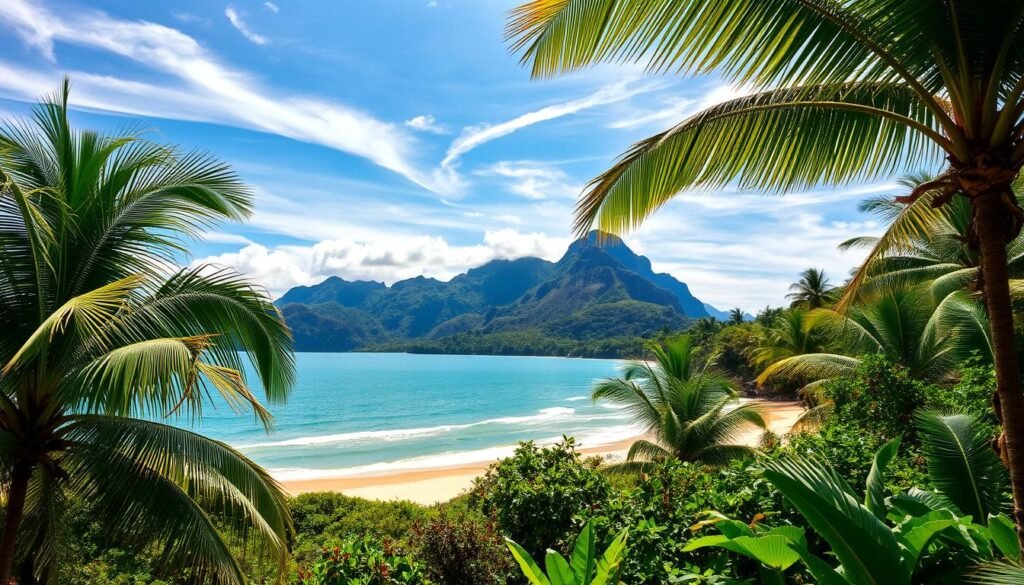Surprising fact: over 80% of travelers say their trip felt best when they caught Thailand’s cool, dry stretch from November through March.
I plan my trips around that clear window because days are sunny, humidity drops, and temperatures sit in the comfortable 80s–90s °F. That stretch suits city walks, jungle treks, and most beach days.
But the country is bigger than one season. The Andaman coast (Phuket, Krabi, Phi Phi) tends to shine late October through May, while the Gulf islands (Koh Samui, Koh Phangan, Koh Tao) often show their calmest weather in mid-year.
April brings the hottest days and May–October brings short, sharp downpours that usually clear fast. I balance crowds, prices, and events—like Yi Peng lanterns in November and Songkran in April—when I pick dates.
If you want a practical primer for planning, check my notes and linked guide for seasonal details and festival timing: planning help for travel in Thailand.
Key Takeaways
- November–March is the most comfortable stretch for most activities.
- Andaman and Gulf coasts have opposite peak windows—plan by region.
- April is hottest; May–October brings quick, heavy rains.
- High, shoulder, and low seasons affect crowds and prices.
- Major festivals can shape your trip—book early for popular events.
The quick answer: when I plan my trip for the best weather
https://www.youtube.com/watch?v=0Bz5NJW_Tas
My go-to window for steady skies and comfortable days runs from November through February. In that winter stretch the air is drier, humidity drops, and temperatures sit around 84–95°F (29–35°C). That combination makes sightseeing and beach time more pleasant.
Why November to February delivers dry skies, comfy temperatures, and sunny days
I usually book travel in this season when I want reliably dry skies, lower humidity, and warm-but-comfy conditions for touring and beach days. Bangkok feels easier, Chiang Mai evenings can be breezier, and Andaman sea trips have calmer water for snorkeling.
- Higher demand in winter means I reserve hotels and trains early, especially for December holidays.
- I pack sun protection and lightweight layers—cooler here still means tropical warmth, so I plan rest days.
- Clear light in this season makes photos of temples, jungles, and coastlines really pop.
If you want a short summary: november february is my sweet spot for comfort and consistency when I plan a trip.
Seasons in Thailand explained for future trips
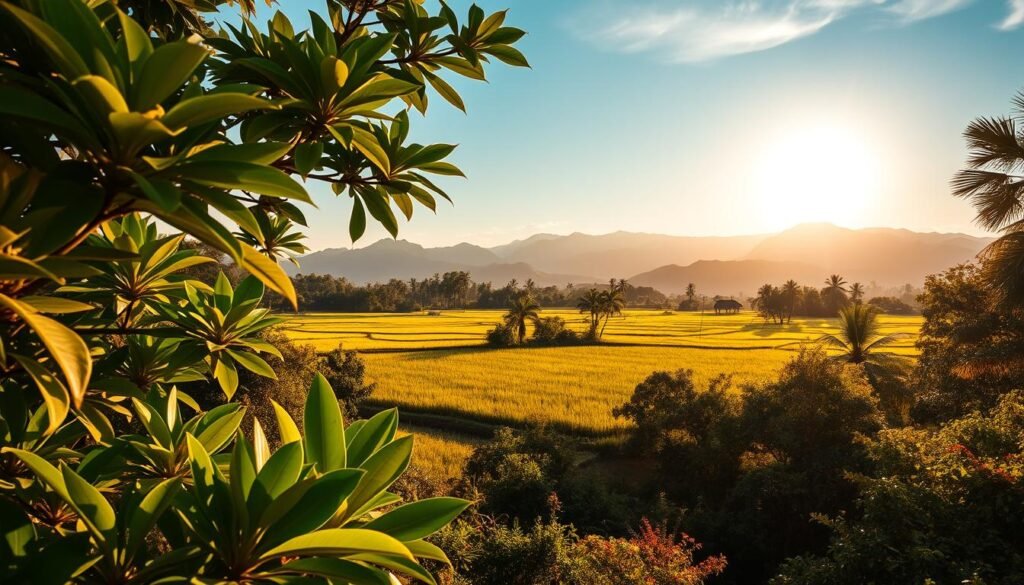
“Thailand’s climate splits into three clear seasons, and I use that map when I plan my next trip.”
Cool and dry: November–February
The cool, dry stretch runs across most of the country from November through February. I pick these months for outdoor touring, hikes, and long city walks because rain rarely interrupts plans.
Hot season: March–June
March through June brings soaring heat, with April often the peak. I schedule early starts, plan water-based days, and rely on air conditioning during midday.
Rainy season: May–October
The rainy season usually runs from May into October. Showers often arrive as short, sharp storms that clear fast, but humidity stays high. I expect occasional itinerary tweaks: some boats or hikes can be affected.
“The green season also has perks—lush rice fields, full waterfalls, and fewer travelers.”
- Regional timing matters: the Andaman and Gulf coasts feel the monsoon at different months.
- Pack smart: light fabrics, hydration, and flexible plans make the year easier to enjoy.
best time to visit thailand by region and coast
Rather than a single window, I map my trip by region and coastal weather patterns. That approach helps me match activities with the most reliable months for each area.
Bangkok and central Thailand
Bangkok stays warm year-round, so I aim for Nov–Jan when humidity drops and temple walks feel easier. Markets and river cruises are more pleasant then, with fewer heat interruptions.
Northern Thailand and Chiang Mai
In northern thailand I enjoy cool nights from November through February and pack a light sweater. I avoid March–April if smoke from agricultural burning bothers me—chiang mai can hit 101°F and haze reduces visibility.
Andaman Sea, west coast
The andaman sea and the west coast—places like Phuket, Krabi, koh lanta, and phi phi—shine from late October/November through April or May. Seas calm, visibility improves, and dive sites like the Similan and Surin islands reopen for top conditions.
Gulf of Thailand, east coast
When summer rolls around, I shift toward the gulf thailand islands. Koh samui, koh phangan, and koh tao often enjoy drier months June–September, making the east coast a solid pick for reliable beach days.
- Check operations: some west-coast resorts scale back in monsoon months, so I verify ferry schedules and park openings.
- Pairing tips: I pair Bangkok + Chiang Mai in winter with Andaman islands, or Bangkok + Samui in summer for smoother weather across coasts.
Beaches and islands: timing the Andaman vs Gulf for perfect coast days
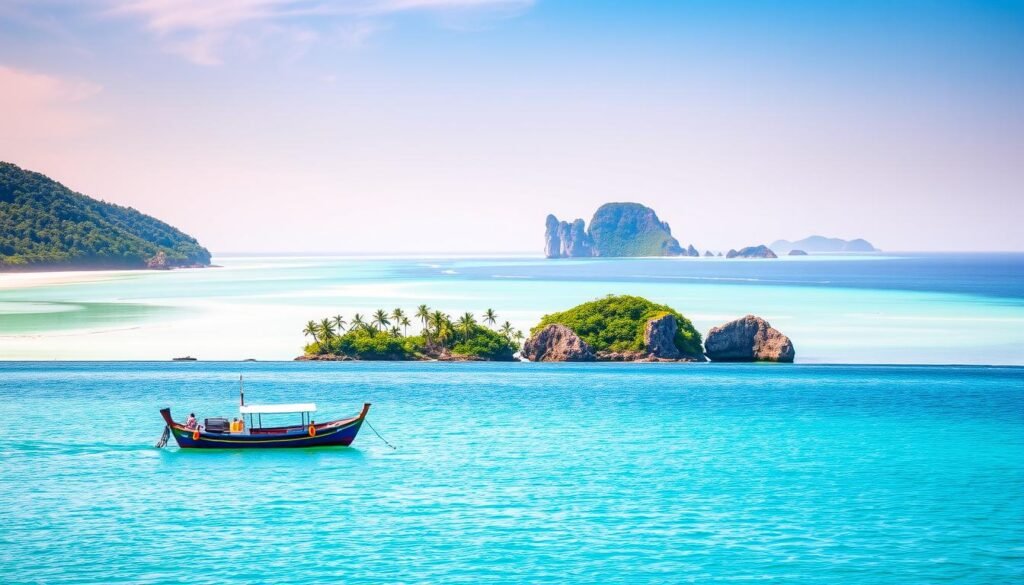
When I plan island days I match the coast and month so I catch calmer water and clearer skies.
West coast window
I favor the west coast—Phuket, Krabi, Koh Lanta, Phi Phi—between late October and May. Seas calm and visibility improves, which makes snorkeling and diving far easier.
Note: Similan and Surin marine parks usually operate from November to mid-May, so I book dives in that window.
East coast window
For the Gulf side I shift plans toward June through September when Koh Samui, Koh Phangan, and Koh Tao often have sunnier spells. The east can be the drier pick in those summer months.
- I schedule Andaman beach trips for late October–May to count on smoother boat rides.
- On the Gulf side I lean into June–September for easier island-hopping.
- In shoulder months I watch ferry advisories and keep one flex day in my plan.
- If dramatic surf scenes appeal, I accept choppier seas on the Andaman during its wet months.
“I book beachfront stays early in peak months—prime rooms go fast.”
Festivals and events I plan around
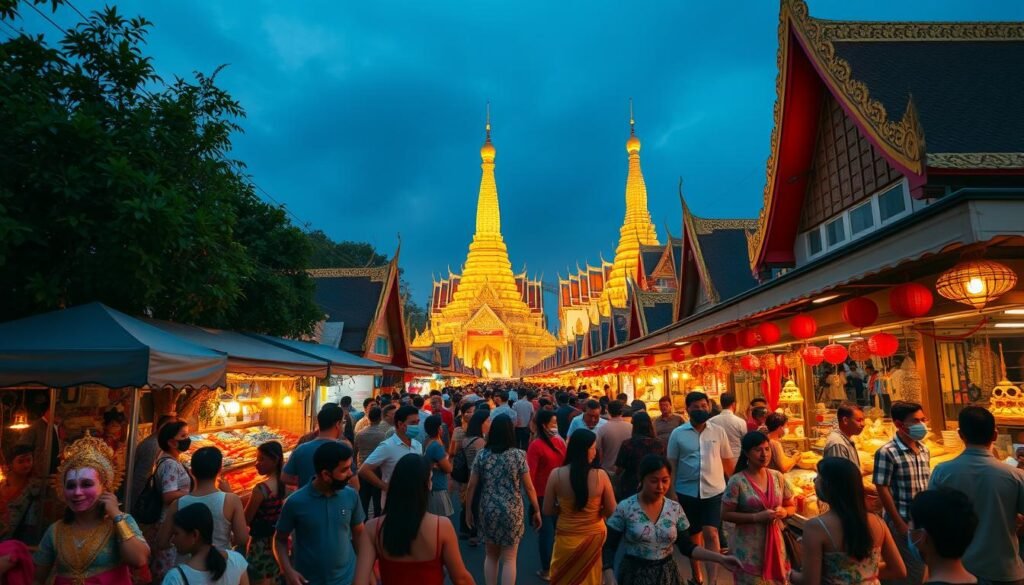
Festivals change an ordinary trip into something memorable. I often arrange dates around a few signature celebrations that light up streets, temples, and beaches.
November lantern magic: Yi Peng in Chiang Mai and Loy Krathong nationwide
I time a November trip to see Yi Peng’s sky lanterns in Chiang Mai and the floating krathongs of Loy Krathong across the country. Nights glow, and processions fill the old city.
Songkran New Year in mid-April: the coolest way to beat the heat
Songkran, the Thai new year, floods streets with friendly water fights in mid-April. I pack quick-dry clothes and a camera cover for wet, joyful days.
Lunar New Year and Chiang Mai Flower Festival in January-February
For the Lunar new year I head to Bangkok’s Chinatown; in February I catch Chiang Mai’s Flower Festival for colorful parades and local blooms.
Phuket Vegetarian Festival in September or October
The Phuket vegetarian festival spans nine intense days in one month. I watch processions and respect strict local customs while photographing safely.
- Book early: festival weeks fill fast and rates rise.
- Pack smart: modest clothes for temples, quick-dry gear, and comfy shoes.
- Check dates: many events follow lunar calendars and shift times each year.
“I often build an itinerary around a festival, then add a coast that’s in season to round out the trip.”
Note: If you plan to visit thailand for a festival, allow extra travel buffers for crowds and road closures.
Budget and crowds: choosing high, shoulder, or low season
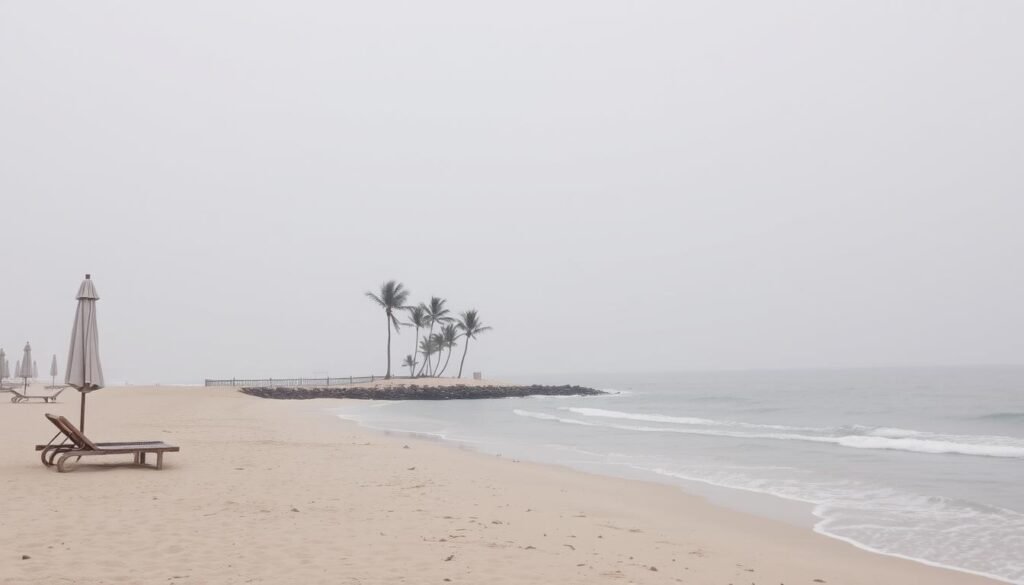
“Picking the right season means balancing rates, weather risks, and the crowd levels I’m willing to accept.”
I sort trips by what I’ll trade: steady sun and higher prices, or quieter beaches and lower rates. In practice that means choosing between high, shoulder, and low options.
High season (November–March)
High season runs across the Nov–Mar months and brings sunny weather and peak demand. I prebook ferries, trains, and hotels so I don’t get squeezed by limited rooms or surprise rates.
Shoulder season (April–June and October)
Shoulder months are my value play. I often find great rooms at lower cost, with some heat or short transitional rain but fewer crowds.
Low season (July–September)
The low season aligns with heavier rain in parts of the country. That gives me greener landscapes, cheaper stays, and a real chance to avoid lines.
- Plan buffers: I budget extra time for weather delays and confirm which tours and boats are running.
- Family vacations: I weigh savings against choppy seas on the Andaman side in July–September.
- City options: Museums and covered markets make a rainy day a good time travel choice.
“I consider the ‘cost of crowds’—time in lines versus the premium I pay for sky certainty.”
Month-by-month overview to match your travel style
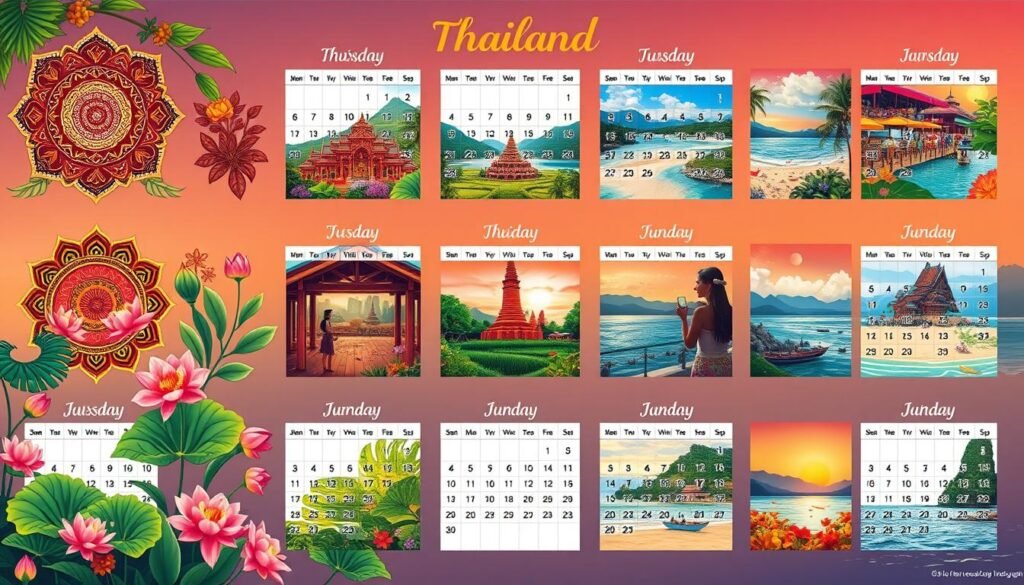
I break the year into short windows so I can match mood, activities, and likely weather for each trip. Below I summarize how each month cluster plays out and what I choose based on crowds, temperatures, and coastal conditions.
Nov–Feb: prime for city touring and beach escapes
January is cool, dry, and sunny across much of the country. February adds festivals like the Chiang Mai Flower Festival.
Why I go: clear skies, pleasant temperatures, and easy sightseeing. I often pair Bangkok and Chiang Mai with Andaman islands like Phi Phi.
Mar–Apr: hottest months, great for island time and Songkran
March starts the heat; April is the peak and hosts Songkran. I plan early mornings and long beach afternoons.
May–Jun: early rains, quieter coasts, good flight values
I expect brief showers and greener landscapes. Prices fall and flights often cost less—ideal if I want quieter islands and photos.
Jul–Sep: rainy season realities, with east coast as a drier bet
These months bring the monsoon for the west coast. I pivot to the east coast — Koh Samui, Koh Phangan, Koh Tao — when I need more reliable beach days.
Oct: transition month with improving conditions in the west
October often clears late in the month. I watch local forecasts and marine advisories before booking Andaman boat trips or diving around Koh Lanta and Phuket.
“I check forecasts, keep a flex day, and pack indoor options so weather never ruins a trip.”
For more detailed regional notes and planning help, see planning help for travel in Thailand.
What I pack and how I dress for the climate and culture
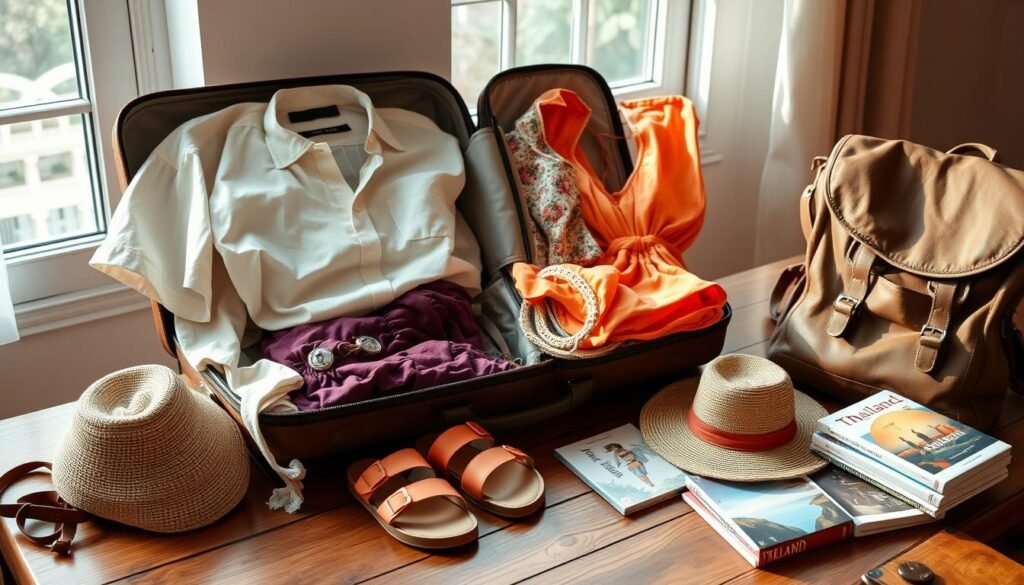
I pack with climate and culture in mind so I can enjoy sunny days and sudden showers without fuss. Breathable cottons and linens are my go-tos; they dry fast and keep me cool in high humidity.
Light, breathable layers and a cardigan for cool evenings up north
What I wear: short-sleeve shirts, a couple of quick-dry bottoms, and one light cardigan for crisp nights in northern thailand during Nov–Feb.
Temple etiquette: covered shoulders and knees, slip-on shoes
I always carry a wrap or scarf for instant coverage. Slip-on shoes are handy since many temples and homes ask you to remove footwear at the door.
Beach basics: sun protection and modest cover-ups off the sand
On beach days I pack reef-safe sunscreen, a hat, sunglasses, and a modest cover-up for walking through towns. A compact rain jacket handles short bursts of rain in the wet season.
- I rotate two or three outfits and do quick laundry—humidity means more frequent washes.
- A dry bag keeps electronics safe year round on boats and during sudden showers.
- I carry insect repellent and a small first-aid kit for hikes and night markets.
“Dressing modestly off the sand goes a long way in this welcoming country.”
For a practical checklist and travel-friendly brands, I follow a short packing guide I trust: Thailand packing list.
Conclusion
I prefer building itineraries around reliable weather pockets rather than a fixed month on the calendar.
I plan November–February when I want the clearest mix of dry days and cooler nights across the country. April stays the hottest month, and May–October brings the rainy season, with regional exceptions on each coast.
If I can’t travel in winter, I pick the coast that’s on: the west coast for late October–May, or the east coast and Koh Samui for summer months. Festivals like Yi Peng, Songkran, and the Flower Festival shape my dates when I want local color.
I pack breathable layers, a light jacket for northern nights, and one flex day for boats or hikes. Match your month to the activities you want, and this destination will deliver memorable days year round.


